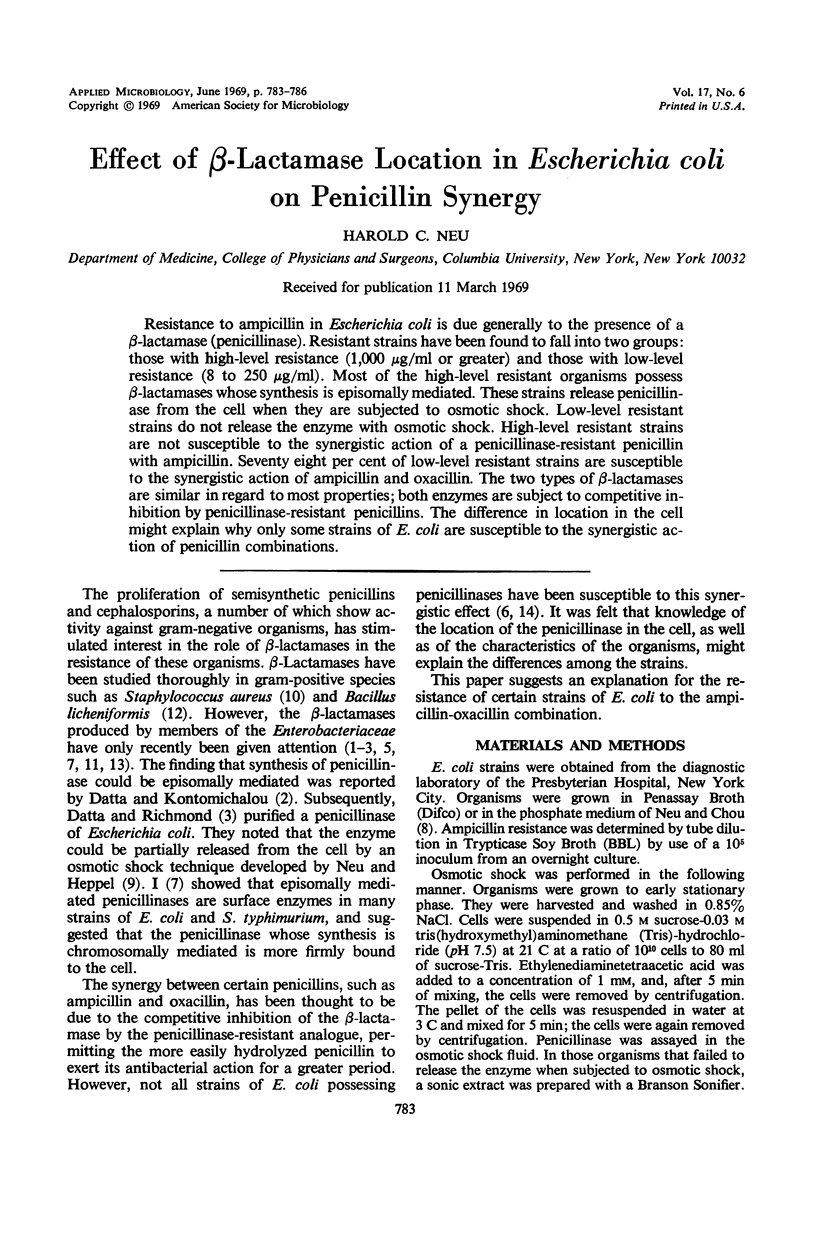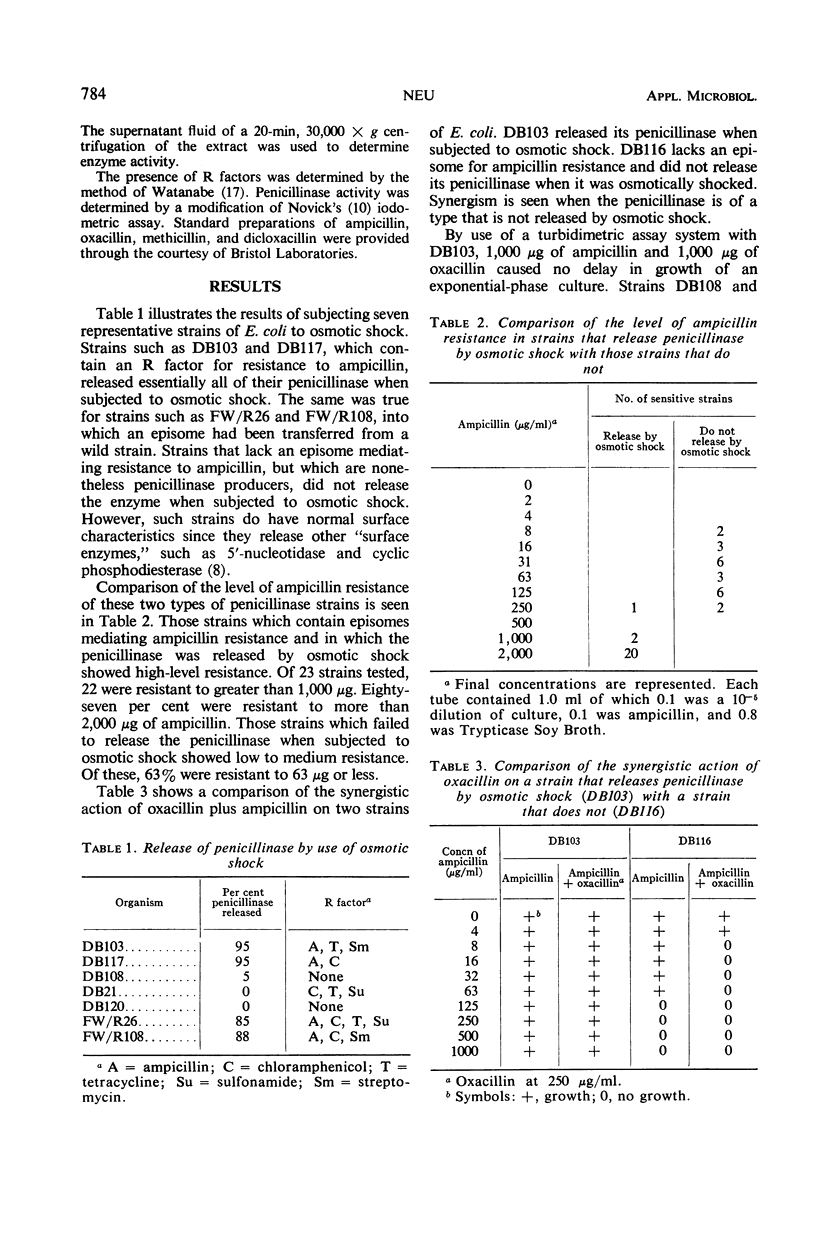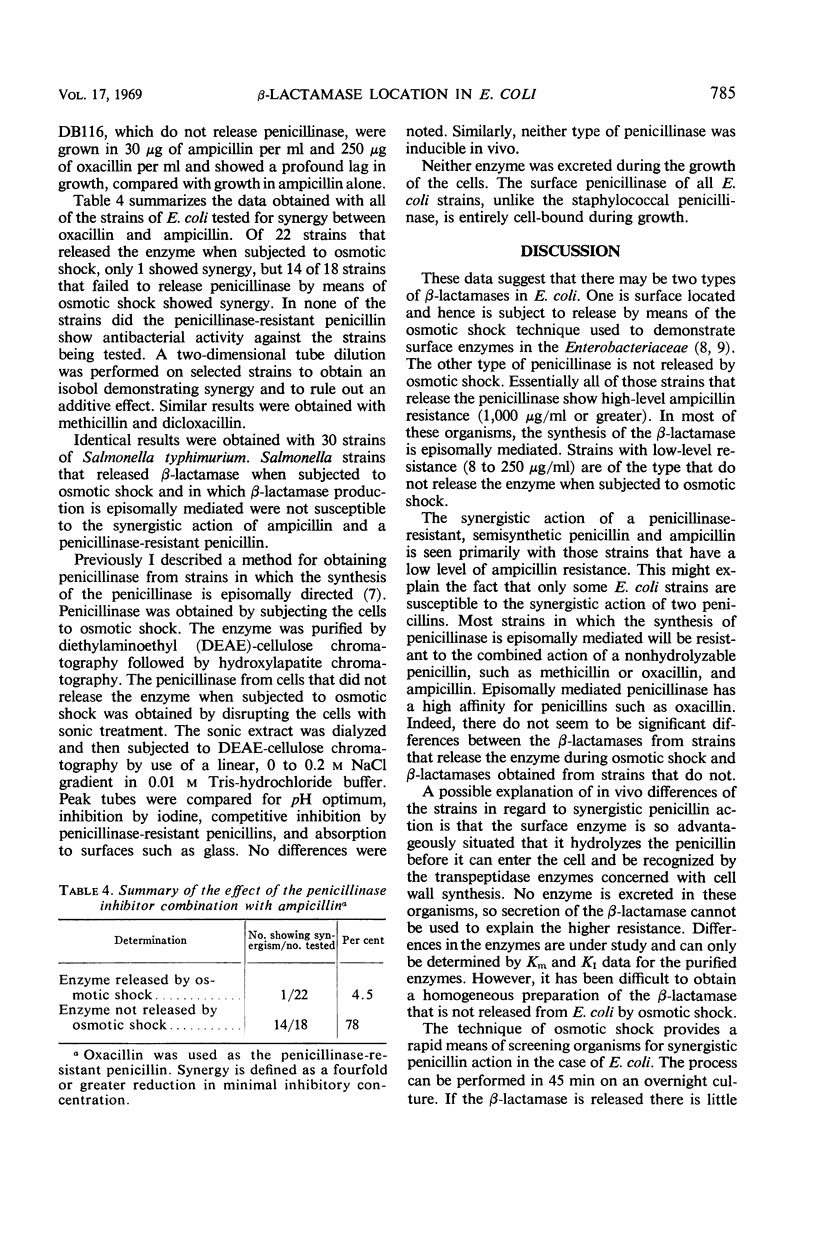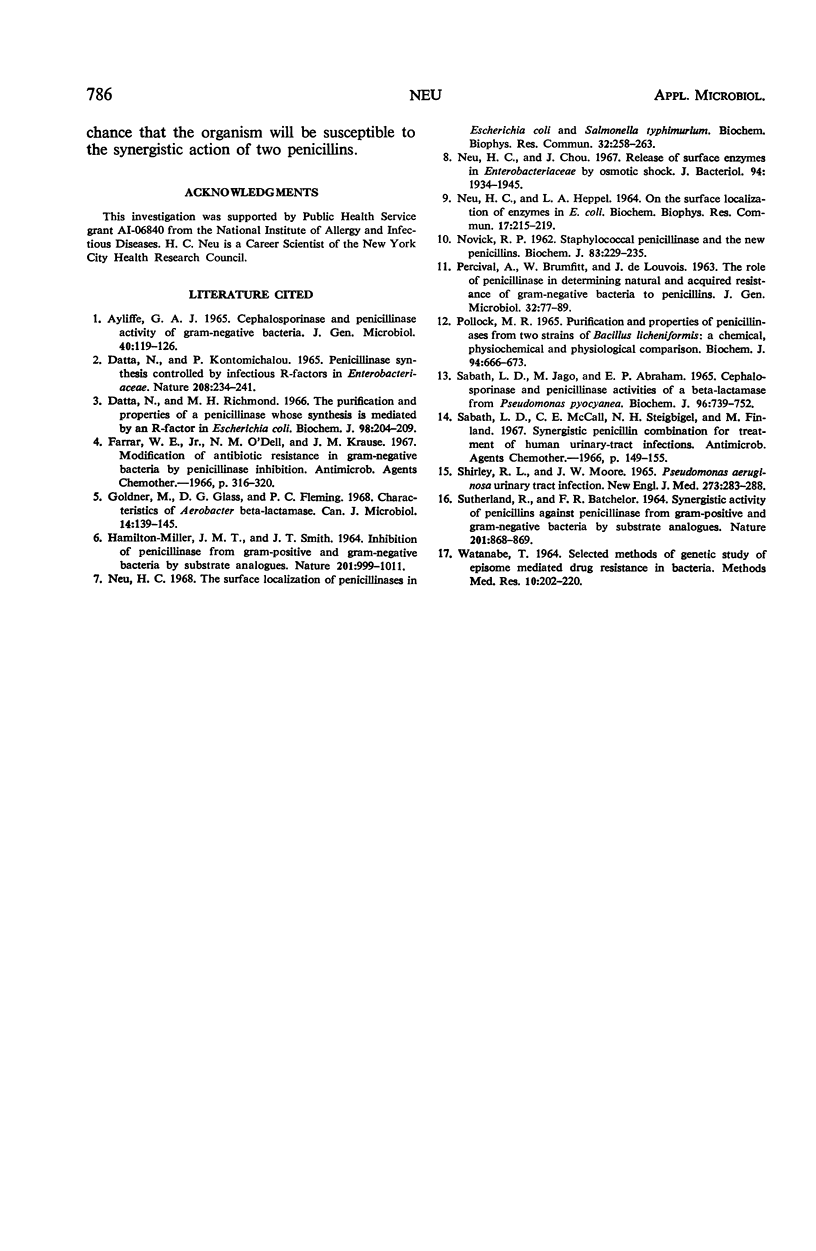Abstract
Resistance to ampicillin in Escherichia coli is due generally to the presence of a β-lactamase (penicillinase). Resistant strains have been found to fall into two groups: those with high-level resistance (1,000 μg/ml or greater) and those with low-level resistance (8 to 250 μg/ml). Most of the high-level resistant organisms posses β-lactamases whose synthesis is episomally mediated. These strains release penicillinase from the cell when they are subjected to osmotic shock. Low-level resistant strains do not release the enzyme with osmotic shock. High-level resistant strains are not susceptible to the synergistic action of a penicillinase-resistant penicillin with ampicillin. Seventy eight per cent of low-level resistant strains are susceptible to the synergistic action of ampicillin and oxacillin. The two types of β-lactamases are similar in regard to most properties; both enzymes are subject to competitive inhibition by penicillinase-resistant penicillins. The difference in location in the cell might explain why only some strains of E. coli are susceptible to the synergistic action of penicillin combinations.
Full text
PDF



Selected References
These references are in PubMed. This may not be the complete list of references from this article.
- Ayliffe G. A. Cephalosporinase and penicillinase activity of Gram-negative bacteria. J Gen Microbiol. 1965 Jul;40(1):119–126. doi: 10.1099/00221287-40-1-119. [DOI] [PubMed] [Google Scholar]
- Datta N., Kontomichalou P. Penicillinase synthesis controlled by infectious R factors in Enterobacteriaceae. Nature. 1965 Oct 16;208(5007):239–241. doi: 10.1038/208239a0. [DOI] [PubMed] [Google Scholar]
- Datta N., Richmond M. H. The purification and properties of a penicillinase whose synthesis is mediated by an R-factor in Escherichia coli. Biochem J. 1966 Jan;98(1):204–209. doi: 10.1042/bj0980204. [DOI] [PMC free article] [PubMed] [Google Scholar]
- Farrar W. E., Jr, O'Dell N. M., Krause J. M. Modification of antibiotic resistance in gram-negative bacteria by penicillinase inhibition. Antimicrob Agents Chemother (Bethesda) 1966;6:316–320. doi: 10.1128/AAC.6.3.316. [DOI] [PubMed] [Google Scholar]
- Goldner M., Glass D. G., Fleming P. C. Characteristics of Aerobacter beta-lactamase. Can J Microbiol. 1968 Feb;14(2):139–145. doi: 10.1139/m68-023. [DOI] [PubMed] [Google Scholar]
- HAMILTON-MILLER J. M., SMITH J. T. INHIBITION OF PENICILLINASES FROM GRAM-POSITIVE AND GRAM-NEGATIVE BACTERIA BY SUBSTRATE ANALOGUES. Nature. 1964 Mar 7;201:999–1001. doi: 10.1038/201999a0. [DOI] [PubMed] [Google Scholar]
- NOVICK R. P. Staphylococcal penicillinase and the new penicillins. Biochem J. 1962 May;83:229–235. doi: 10.1042/bj0830229. [DOI] [PMC free article] [PubMed] [Google Scholar]
- Neu H. C., Chou J. Release of surface enzymes in Enterobacteriaceae by osmotic shock. J Bacteriol. 1967 Dec;94(6):1934–1945. doi: 10.1128/jb.94.6.1934-1945.1967. [DOI] [PMC free article] [PubMed] [Google Scholar]
- Neu H. C., Heppel L. A. On the surface localization of enzymes in E. coli. Biochem Biophys Res Commun. 1964 Oct 14;17(3):215–219. doi: 10.1016/0006-291x(64)90386-9. [DOI] [PubMed] [Google Scholar]
- Neu H. C. The surface localization of penicillinases in Escherichia coli and Salmonella typhimurium. Biochem Biophys Res Commun. 1968 Jul 26;32(2):258–263. doi: 10.1016/0006-291x(68)90378-1. [DOI] [PubMed] [Google Scholar]
- PERCIVAL A., BRUMFITT W., DE LOUVOIS J. THE ROLE OF PENICILLINASE IN DETERMINING NATURAL AND ACQUIRED RESISTANCE OF GRAM-NEGATIVE BACTERIA TO PENICILLINS. J Gen Microbiol. 1963 Jul;32:77–89. doi: 10.1099/00221287-32-1-77. [DOI] [PubMed] [Google Scholar]
- POLLOCK M. R. PURIFICATION AND PROPERTIES OF PENICILLINASES FROM TWO STRAINS OF BACILLUS LICHENIFORMIS: A CHEMICAL, PHYSICOCHEMICAL AND PHYSIOLOGICAL COMPARISON. Biochem J. 1965 Mar;94:666–675. doi: 10.1042/bj0940666. [DOI] [PMC free article] [PubMed] [Google Scholar]
- SUTHERLAND R., BATCHELOR F. R. SYNERGISTIC ACTIVITY OF PENICILLINS AGAINST PENICILLINASE-PRODUCING GRAM-NEGATIVE BACILLI. Nature. 1964 Feb 29;201:868–869. doi: 10.1038/201868a0. [DOI] [PubMed] [Google Scholar]
- Sabath L. D., Jago M., Abraham E. P. Cephalosporinase and penicillinase activities of a beta-lactamase from Pseudomonas pyocyanea. Biochem J. 1965 Sep;96(3):739–752. doi: 10.1042/bj0960739. [DOI] [PMC free article] [PubMed] [Google Scholar]
- Sabath L. D., McCall C. E., Steigbigel N. H., Finland M. Synergistic penicillin combinations for treatment of human urinary-tract infections. Antimicrob Agents Chemother (Bethesda) 1966;6:149–155. [PubMed] [Google Scholar]
- WATANABE T. SELECTED METHODS OF GENETIC STUDY OF EPISOME-MEDIATED DRUG RESISTANCE IN BACTERIA. Methods Med Res. 1964;10:202–220. [PubMed] [Google Scholar]


